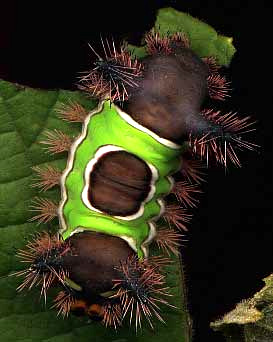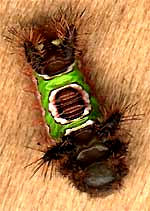Excerpts from Jim Conrad's
Naturalist Newsletter
from the July 4, 2004 Newsletter, issued from near Natchez, Mississippi:
PAINFULLY PRETTY
Late Wednesday as the afternoon storm rained itself out I heard a car-horn tooting and here came my neighbor Karen slipping and sliding through the mud. She carried a shoebox and wore a flustered expression. While mowing beneath a pear tree she'd brushed against some low-hanging limbs and something had stung her. Now her aching arm bore large, red wheals, her mouth had a cottony feeling and maybe she was even getting dizzy. The culprit was in the shoebox and she wanted to know what it was.
 I knew the villain at first glimpse, for back in the 70s one day I'd brushed beneath an apple tree in Kentucky, got stung the same way, and once you undergo that experience you're not likely to forget the perpetrator. Boldly marked with a broad, dayglow-green design outlined in white on a dark brown body, and absolutely bristling with sharp hairs, it was a Saddleback Caterpillar, SIBINE STIMULEA, a member of the Slug Caterpillar family of moths, the Limacodidae. That's it at the right.
I knew the villain at first glimpse, for back in the 70s one day I'd brushed beneath an apple tree in Kentucky, got stung the same way, and once you undergo that experience you're not likely to forget the perpetrator. Boldly marked with a broad, dayglow-green design outlined in white on a dark brown body, and absolutely bristling with sharp hairs, it was a Saddleback Caterpillar, SIBINE STIMULEA, a member of the Slug Caterpillar family of moths, the Limacodidae. That's it at the right.
Saddleback Caterpillars are fairly common at forest edges, in orchards and in vegetable gardens throughout most of the eastern US. Their hairs are like hypodermic needles that can inject poison into one's skin. The irritation can last for a day or two and might be accompanied by nausea during the first few hours. Anyone getting stung should wash the affected area, then apply an ice pack to reduce swelling. Creams and lotions containing steroids lessen the pain. If you're particularly sensitive to insect stings you should get a doctor's advice.
If you view my picture, notice that one end of the caterpillar features two bright yellow spots. If a predator such as a bird isn't deterred by the stinging hairs and wants to disable the caterpillar by attacking its head, probably it'll be attracted to the end bearing the yellow spots. If that happens, it'll be the wrong end, for the spots are on the rear. Therefore this caterpillar not only has bright colors and bold markings to warn predators away, as well as all those stinging hairs, but also a "decoy head." This is one caterpillar that Mother Nature really wanted to survive!
from the November 4, 2001 Newsletter, issued from near Natchez, Mississippi:
SADDLEBACK CATERPILLAR
 Friday morning I found one of the most gorgeous of all caterpillars on a piece of kindling in my woodpile. I already knew this species' name, however, because when I was a kid in Kentucky once I managed to get one down my shirt and into my armpit, and it felt like I'd been stung by a dozen wasps. That's it at the right.
Friday morning I found one of the most gorgeous of all caterpillars on a piece of kindling in my woodpile. I already knew this species' name, however, because when I was a kid in Kentucky once I managed to get one down my shirt and into my armpit, and it felt like I'd been stung by a dozen wasps. That's it at the right.
It's the Saddleback Caterpillar, Sibine stimulea. Notice that it's covered with sharp spines. Those spines convey poison from glands at the spines' bases into a victim's flesh.
The Saddleback seeks with its bold colors and pattern to warn the world that it is not to be fooled with.